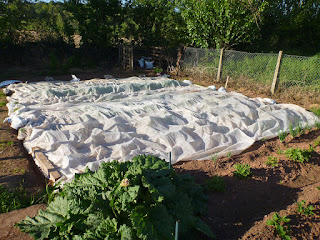Protecting Early Plants from Frost
The end of March can be a cold time of the year in the UK and there's more chance of snow than at Christmas. Temperatures in spring can vary quite widely from one day to the next and warmer days can lull you into a false sense of security.
The plants you can see on the allotments now are all frost-hardy. They will either be mature plants which have been over-wintered: kale, leeks, sprouts, parsnips, purple-sprouting broccoli... or younger - but still frost-hardy types - garlic, shallots and spring cabbages for example.
It's a good time to start sowing a few early new-season crops - just make sure you have the means to protect them from frosts, which can occur right up to the middle of May! Horticultural fleece is ideal: it warms and protects plants while letting through rain and light. Later on you can also use it as a windbreak around upright plants like broad beans (see photo below left).
Some people cover their early plants with fleece as soon as they've been sown and leave it in place until May. I like to remove mine on sunny days to air the crops and clear out any slugs hiding under it. It is much easier to leave your protection in place instead of rushing down to the allotment every time a frost is forecast to cover your vulnerable plants. If you only have one fleece remember to grow your early crops together in one area which you can cover.
If you don't have a fleece there are other options. Potatoes can be ridged up with more earth, or compost, and you can cover emerging plants with straw (see photo below right). Cloches can be home-made or bought in many sizes and can be useful for covering a row or individual plants. You may need to water underneath occasionally if you use plastic or glass as a cloche (always use glass responsibly and only use toughened or safety glass at the allotments).
The plants you can see on the allotments now are all frost-hardy. They will either be mature plants which have been over-wintered: kale, leeks, sprouts, parsnips, purple-sprouting broccoli... or younger - but still frost-hardy types - garlic, shallots and spring cabbages for example.
It's a good time to start sowing a few early new-season crops - just make sure you have the means to protect them from frosts, which can occur right up to the middle of May! Horticultural fleece is ideal: it warms and protects plants while letting through rain and light. Later on you can also use it as a windbreak around upright plants like broad beans (see photo below left).
Some people cover their early plants with fleece as soon as they've been sown and leave it in place until May. I like to remove mine on sunny days to air the crops and clear out any slugs hiding under it. It is much easier to leave your protection in place instead of rushing down to the allotment every time a frost is forecast to cover your vulnerable plants. If you only have one fleece remember to grow your early crops together in one area which you can cover.
If you don't have a fleece there are other options. Potatoes can be ridged up with more earth, or compost, and you can cover emerging plants with straw (see photo below right). Cloches can be home-made or bought in many sizes and can be useful for covering a row or individual plants. You may need to water underneath occasionally if you use plastic or glass as a cloche (always use glass responsibly and only use toughened or safety glass at the allotments).
Submitted by Tigger

Comments
Post a Comment